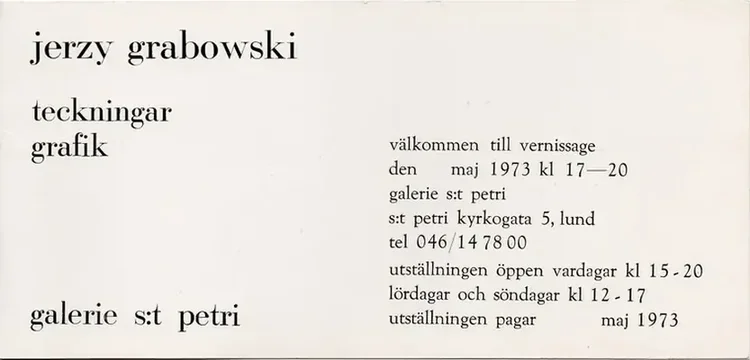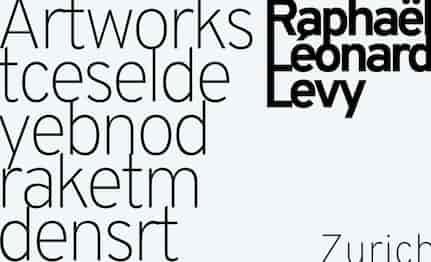CLICK TO VIEW PRESS RELEASE

JERZY GRABOWSKITECKNINGAR GRAFIK11-23 May 1973
galerie s:t petri
s:t petri kyrkogata 5
lund
046 / 14 78 00
Datakonst kan de grafiska blad kallas – som JERZY GRABOWSKI från Warszawa visar i Galerie S:t Petri under tiden 11 – 23 maj.
Sedan flera år har denne konstnär sysslat med objektivitetsproblemet i bildkonsten. Redan i slutet av 1950-talet ställde han sig kritisk till tesen om konstens subjektiva väsen. Med hjälp av matematik, fysik och datateknik har han i sitt konstnärliga skapande sökt integrera vetenskapen, konsten och tekniken.
Över praktiskt taget hela världen har Grabowski visat sina verk: USA, Japan, Frankrike, Danmark, Italien samt naturligtvis i Polen. Moderna muséet och Nationalmuseum i Stockholm hade förra året besök av honom liksom Landskrona konsthall. Lundautställningen blir den första separatutvisningen i Sverige.
Konstnären är närvarande vid vernissagen fredagen den 11 maj kl 17 – 20.
galerie s:t petri
s:t petri kyrkogata 5
lund – sweden
046 / 14 78 00
JERZY GRABOWSKI
11 – 23 May 1973
Born in 1933 in Poland. Completed his studies at Warsaw’s Academy of Fine Arts. The diploma conferred upon him in 1962. Member of the Polish Plastic Artist Union (ZPAP), and of the International Association af Art.
Individual exhibitions: Warsaw 1963, 1964; Copenhagen 1968; Stockholm 1968, 1969; Gdynia 1973. Participat in international, and special art exhibitions.
Works included in collections of the National Museum–Poster Museum at Warsaw/Wilanów, the National Museum in Szczecin, the Nationalmuseum and the Moderna Muséet in Stockholm, Landskrona Museum. More work can be found in Art Societies and private collections in Austria, Czechoslovakia, Denmark, France, Italy, Japan, Poland, Switzerland, Sweden, USA.
Opposing the influence and criteria of aesthetics and subjektive trends, has been for years occupied with problems of objective phenomenon in plastic art with mathematics and physics involved. Examining the integration of art with technical science.
galerie s:t petri
s:t petri kyrkogata 5
lund
046 / 14 78 00
JERZY GRABOWSKI – born 1933 in Gutki, Poland
11–23 May 1973
“During my final years at the Academy of Fine Arts in Warsaw, my critical attitude toward the art movements in Poland was shaped. I became aware of the influence of the ‘academists’ on me and grew skeptical toward the thesis of art’s subjective essence.
By analogy I came to the conclusion that science, technology, and especially mathematics could assist me in my search, facilitating my liberation from emotionally subjective art and from aesthetic academism. I checked the rules and laws that apply in art to color, surface, picture composition, perspective, legibility. Nature studies, though not impressionistic-emotional, clarified the close affinity between the appearance of constructions of certain elements and those same elements themselves in relation to matter and the world of thought (symmetries, diagonals, axiality, etc.). The whole is integrated—therefore art must be extracted from the developmental totality that builds upon the artist’s subjective experiences. Beauty does not exist only within us; it also exists outside.
Nature and technology are changing at a rapid pace. Everything people do changes. This is expressed in certain structural patterns in my compositions. Sometimes I tear them apart, cut them into strips—like a landscape intersected by motorways, railways, runways. The high-rise buildings of the streets are torn to pieces, erased, and assume a different content—at least artistically.
I would like my production to become generally accessible, a mass article like books, records, TV, cars, irons, bread. Then the workplace must be radically altered—moving from the painter’s studio to the factory hall and the data center, where one can produce a number of identical and equivalent paintings. It is not reproduction I am after. The shift of the workshop is a way to win back lost time in the realization of the task. The events of today and their criteria are not the same as those of the past.
Beyond mathematics and technology, folk art has provided inspiration. I feel especially close to the art of the Białystok region. There I have found many concrete examples of objective creation of an objective aesthetics. Folk art has the characteristic that it is less affected by academism and modern directions, and it preserves an original approach. The most varied compositions and structural elements in my work consciously connect with folk art. The elements themselves are often aggressive in nature, though unconsciously and without claims to any special meaning. They are simply corresponding mathematical units, code elements. The coloristic composition is primarily the effect of calculation.
I advocate the integration of science, art, and technology.”


